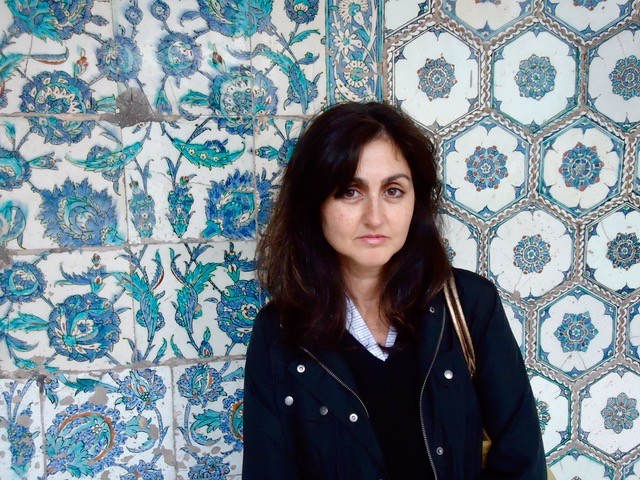Zainab Bahrani Helps Preserve Cultural Heritage in Iraq
On April 23, Zainab Bahrani was named to the 2019 class of Andrew Carnegie Fellows. “It’s a great honor to receive the Carnegie award for my work in Iraq. I am pleased that this distinction will also draw attention to the plight of historical landscapes and the rights and survival of communities within them. The grant will permit me to write a book about this work, and to continue with the field documentation and its dissemination in the languages of the region,” said Bahrani.

Zainab Bahrani, the Edith Porada Professor of Ancient Near Eastern Art and Archaeology in the Department of Art History and Archaeology, is leading a project that focuses on heritage destruction in the Middle East. Mapping Mesopotamian Monuments is an ongoing topographical survey that maps the standing historical monuments and architecture in the region from Iraqi Kurdistan and Southeastern Anatolia (Turkey) to Southern Iraq. The survey covers all historical periods and includes ancient Mesopotamian rock reliefs carved into the cliff faces of mountains, early Christian churches and monasteries, and early Islamic, Ottoman and 20th century sites.
Q. You were in Iraq this past October and November to continue your work on Mapping Mesopotamia. Where did you go?
A. First, I want to mention that this project started in 2012 before ISIS even came. Our project is not a response to them. It’s important to document these sites in a general topographical survey. We had no idea ISIS was about to attack, and, in fact, they did soon after our first field season ended in 2013. So it was really good that we had begun this work, especially systematically documenting early Christian monasteries and some of the Yazidi sanctuaries, because so many of them are now destroyed, but at least we have a record of the network of monasteries in northern Mesopotamia. This season, we were closer to the border with Iran. We were there briefly in 2013, when we documented one site in Sulaimaniya, a tomb cut into the cliffs of the mountains, which dates to about the 6th century B.C., with beautiful carvings and traces of paint on the surface that were still intact. But there are a number of things in the region that we didn’t have time to document, so we went back to do those, for example, a series of rock-cut reliefs in the mountains.
Q. After leaving Iraq, you attended a cultural heritage conference at the Columbia Global Center in Amman, Jordan. What was its focus?
A. This was the second part of a workshop that we began in 2015 at the Columbia Global Center in Istanbul. We are supported by a grant from President Bollinger’s Global Innovation Fund, and the workshop was co-sponsored by the Metropolitan Museum of Art. In Istanbul, most of the participants were archaeologists from Turkey, Iraq and Syria. Those who came from Syria had to cross the border going through a very dangerous zone. When the meeting was over, they turned around and went straight back because they needed to work on protecting the sites and museums they are associated with. We discussed the plight of cultural heritage in general, and that included museums, archaeological sites, standing monuments and education.
Q. At a recent conference on war and preservation at Columbia, you discussed how concerns about cultural heritage are not new, but ancient, especially in Mesopotamia. Can you explain?
A. The ancient Mesopotamians were constantly concerned with respect for the remains of the past, and Mesopotamia is the earliest place where we can study such deep historical consciousness. Cultural preservation is often considered a modern or western concern, but this is not the case. In 2500 B.C., a Sumerian monument—the oldest known public monument in history—was erected in southern Iraq. This stele is a monument to victory, and also a contractual agreement, a peace treaty set up after the battle was over. One small aspect of the text that has not been recognized before is astonishing. Among the promises listed on this stele are oaths to the gods that the warring parties would neither destroy nor dislocate the monuments. So the destruction of monuments was already defined as an act of war in the third millennium B.C.
Q. Can you elaborate on the idea that there is a growing dissociation between the monuments and the people who live there?
A. There’s this idea that ancient Mesopotamian sites represent global cultural heritage, which, of course, they do. But somewhere along the line, we’ve forgotten that this is the cultural heritage of the people who actually live there, and they feel very closely tied to it. We’ve formed this separation so much that statements are made about the protection of the heritage without giving too much thought to the people.
Q. What do you think about French President Francois Hollande’s recent proposals to temporarily move artifacts located in conflict zones in Syria and Iraq to France for safekeeping?
A. Again, what about the people who are trying to find a safe haven, especially in Europe? It’s ironic that Hollande would give asylum to endangered antiquities considering that France has been so resistant to taking in more refugees. Since 2003, war has devastated Iraq and Syria. People are being killed and displaced, they are enslaved and tortured, cities demolished. In many cases, it is clear that the attacks on monuments are part and parcel of the strategy to erase the local populations and their histories and to use culture to divide and wipe out history and people alike. This aspect of the cultural destruction has had little attention in comparison to the idea that we should rescue world heritage.